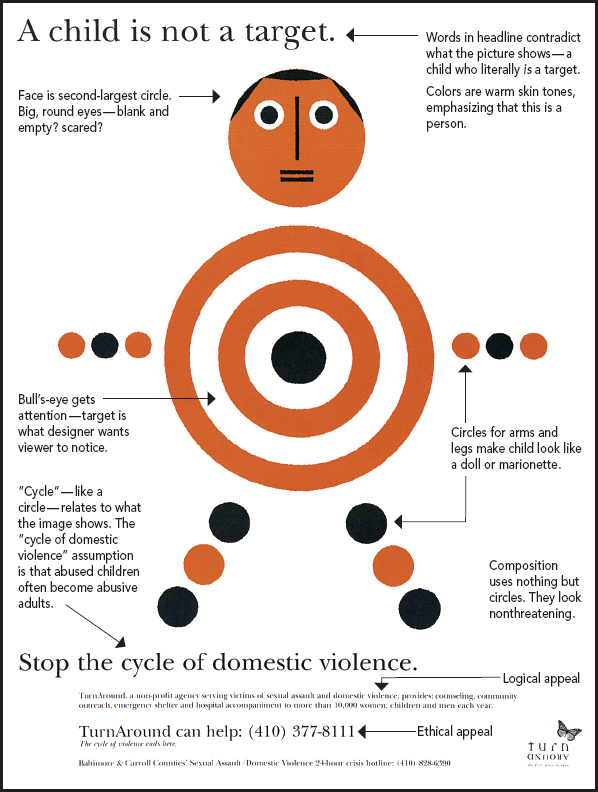8d Reading emotional, ethical, and logical appeals
Aristotle categorized argumentative appeals into three types: emotional appeals that speak to our hearts and values (known to the ancient Greeks as pathos), ethical appeals that appeal to character (ethos), and logical appeals that involve factual information and evidence (logos).
 Analyzing emotional appeals
Analyzing emotional appeals

Emotional appeals stir our emotions and remind us of deeply held values. When politicians argue that the country needs more tax relief, they almost always use examples of one or more families they have met, stressing the concrete ways in which a tax cut would improve the quality of their lives. Doing so creates a strong emotional appeal. Some have criticized the use of emotional appeals in argument, claiming that they are a form of manipulation intended to mislead an audience. But emotional appeals are an important part of almost every argument. Critical readers “talk back” to such appeals by analyzing them, deciding which are acceptable and which are not.
The accompanying photo shows gun-
 Analyzing ethical appeals
Analyzing ethical appeals
Ethical appeals support the credibility, moral character, and goodwill of the argument’s creator. These appeals are especially important for critical readers to recognize and evaluate. Should a respected baseball manager’s credibility in the clubhouse convince you to invest in mutual funds he promotes? Should an actress respected for her award-
When I began developing The Act of Killing in 2005, I had already been filming for three years with survivors of the 1965–66 massacres. I had lived for a year in a village of survivors in the plantation belt outside Medan. I had become very close to several of the families there. During that time, Christine Cynn and I collaborated with a fledgling plantation workers’ union to make The Globalization Tapes, and began production on a forthcoming film about a family of survivors that begins to confront (with tremendous dignity and patience) the killers who murdered their son. Our efforts to record the survivors’ experiences—
—JOSHUA OPPENHEIMER
 Analyzing logical appeals
Analyzing logical appeals
Logical appeals are often viewed as especially trustworthy: “The facts don’t lie,” some say. Of course, facts are not the only type of logical appeals, which also include firsthand evidence drawn from observations, interviews, surveys and questionnaires, experiments, and personal experience; and secondhand evidence drawn from authorities, the testimony of others, statistics, and other print and online sources. Critical readers need to examine logical appeals just as carefully as emotional and ethical ones. What is the source of the logical appeal—
[I]t is well for us to remember that, in an age of increasing illiteracy, 60 percent of the world’s illiterates are women. Between 1960 and 1970, the number of illiterate men in the world rose by 8 million, while the number of illiterate women rose by 40 million.1 And the number of illiterate women is increasing.
—ADRIENNE RICH, “What Does a Woman Need to Know?”
As a critical reader, you would question these facts and hence check the footnote to discover the source, which in this case is the UN Compendium of Social Statistics. At this point, you might accept this document as authoritative—
If you attend closely to the emotional, ethical, and logical appeals in any argument, you will be on your way to analyzing—
 Analyzing appeals in a visual argument
Analyzing appeals in a visual argument
The poster at the bottom of the page, from TurnAround, an organization devoted to helping victims of domestic violence, is “intended to strike a chord with abusers as well as their victims.” The dramatic combination of words and image builds on an analogy between a child and a target and makes strong emotional and ethical appeals.
The bull’s-
This poster’s stark image and headline appeal to viewers’ emotions, offering the uncomfortable reminder that children are often the victims of domestic violence. The design causes viewers to see a target first and only afterward recognize that the target is actually a child—
